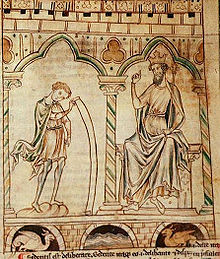
The Prophetiæ Merlini is a Latin work of Geoffrey of Monmouth circulated, perhaps as a libellus or short work,[1] from about 1130, and by 1135.[2][3] Another name is Libellus Merlini.
The work contains a number of prophecies attributed to Merlin, the wizard of legend, whose mythical life is often regarded as created by Geoffrey himself, although Geoffrey claims to have based the figure on older Brittonic traditions, some of which may have been oral but now are lost. The Prophetiae preceded Geoffrey's larger Historia Regum Britanniæ of c. 1136, and was mostly incorporated in it, in Book VII;[4] the prophecies, however, were influential and widely circulated in their own right. According to Geoffrey, he was prompted by Alexander of Lincoln to produce this section of his larger work separately.[5]
- ^ Cite error: The named reference
Barber1999was invoked but never defined (see the help page). - ^ Helen Fulton (1 February 2012). A Companion to Arthurian Literature. John Wiley & Sons. p. 98. ISBN 978-0-470-67237-2. Retrieved 9 May 2012.
- ^ Christopher Harper-Bill; Elisabeth Van Houts (2007). A Companion to the Anglo-Norman World. Boydell & Brewer Ltd. pp. 200–. ISBN 978-1-84383-341-3. Retrieved 9 May 2012.
- ^ Laura C. Lambdin; Robert T. Lambdin (2008). Arthurian Writers: A Biographical Encyclopedia. ABC-CLIO. p. 30. ISBN 978-0-313-34682-8. Retrieved 9 May 2012.
- ^ James L. Kugel (1990). Poetry and Prophecy: The Beginnings of a Literary Tradition. Cornell University Press. p. 151. ISBN 978-0-8014-9568-7. Retrieved 9 May 2012.